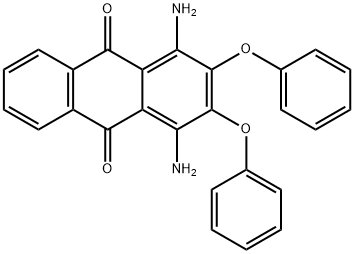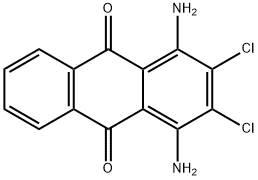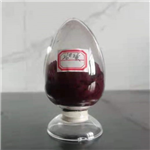General Description
Disperse Violet 26 is a commercial dye, and the attachment of azo groups (N=N) a) is a very important feature of disperse dyes. Disperse Violet 26 is a fluorescent probe used as a commercially available fluorescent dye for the detection of ClO
- . ClO- is one of the important biologically active oxygen species (ROS)[1].
Flammability and Explosibility
Not classified
Synthesis
1,4-Diamino-2,3-diphenoxyanthraquinone
is prepared
from the 2,3-dichloro compound and phenol
by chlorine replacement .
Properties and Applications
red light purple. brown-red powder, soluble in alcohol. The strong sulfuric acid in colorless, diluted red for yellow light. In dyeing calcium and magnesium ions not sensitive, encounter iron ion colored light slightly influence, copper ions in big effect. Dye bath appropriate pH value for 3 to 8, in dyeing and printing not alkali resistance. The dyes red light for purple, suitable for polyester/cotton blended fabric dyeing, and have a good color fastness to dry. Suitable for high temperature high pressure and hot melt dyeing method, hot melt temperature of 210 ~ 220 ℃. In three vinegar on fiber dyeing, colored light and polyester similar, is not suitable for dyeing two vinegar fiber, polyamide fiber and acrylic. But in polyester fabric weaving direct printing, cannot be printing the impression of the discharge. And Disperse Violet 26?and the same chemical structure.
|
Standard
|
Ironing Fastness
|
Light Fastness
|
Persperation Fastness
|
Washing Fastness
|
|
Fading
|
Stain
|
Fading
|
Stain
|
Fading
|
Stain
|
|
ISO
|
4
|
3
|
6
|
5
|
5
|
4-5
|
4-5
|
Waste Disposal
Disperse dyes are recalcitrant in nature and nonbiodegradable, and therefore persistent dyes. At present, wastewater treatment containing dispersed dyes is very challenging, and oxidation is the most well-known and commonly used treatment method for destroying the dye structure. UV-H
2O
2-based systems are often used to improve dye degradation[2].
References
[1] Li J, et al. A selective colorimetric and fluorescent probe for the detection of ClO? and its application in bioimaging. RSC Advances, 2014; 4: 44610-44613.
[2] Jamil A, et al. Photocatalytic degradation of disperse dye
Violet-26 using TiO2 and ZnO nanomaterials and
process variable optimization. Journal of Materials Research and Technology, 2019; 9: 1119-1128.





